Nick Thomas and a crafty carp fly
This fly evolved on a windy and wet winter afternoon. I’d been driven off the river by the cold and dreich drizzle. After several cups of hot coffee and having re-established contact with my frozen feet, I was sitting at the tying bench dreaming of warmer weather. Specifically, a pleasant early misty morning on a carp lake.
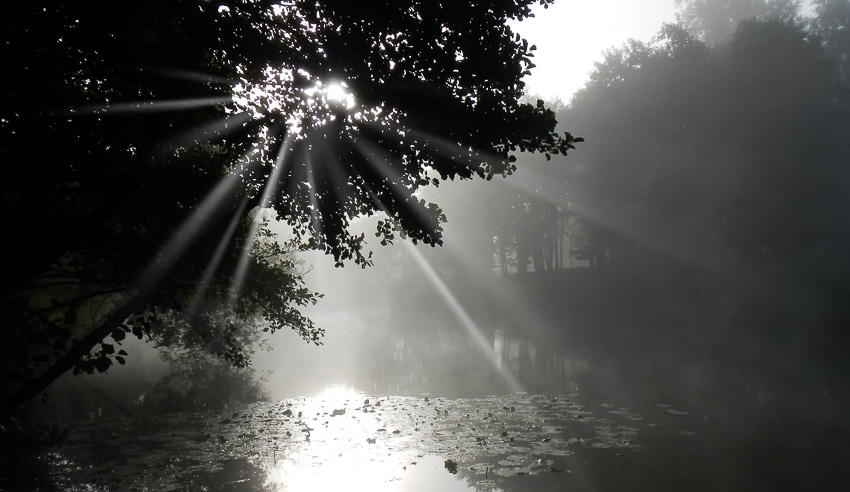
I often find that when I sit at the tying bench I’m making flies for a different season. Quick sessions are dedicated to just filling up spaces in my boxes where I’ve lost flies. Longer sessions which involve experimenting with new patterns are frequently time shifted. Summer flies are tied in the depth of winter and heavy winter nymphs at the height of summer. I guess it’s a human trait always to be wishing for what we haven’t got, but the sense of anticipation of testing a new pattern is always heightened by looking forward to a different type of fishing as the seasons change. On this occasion after messing about a bit with some craft foam, ribbon, some fibres left over from tying salt water bait fish patterns and a packet of unused booby eyes, the Stalking Dragon was hatched.
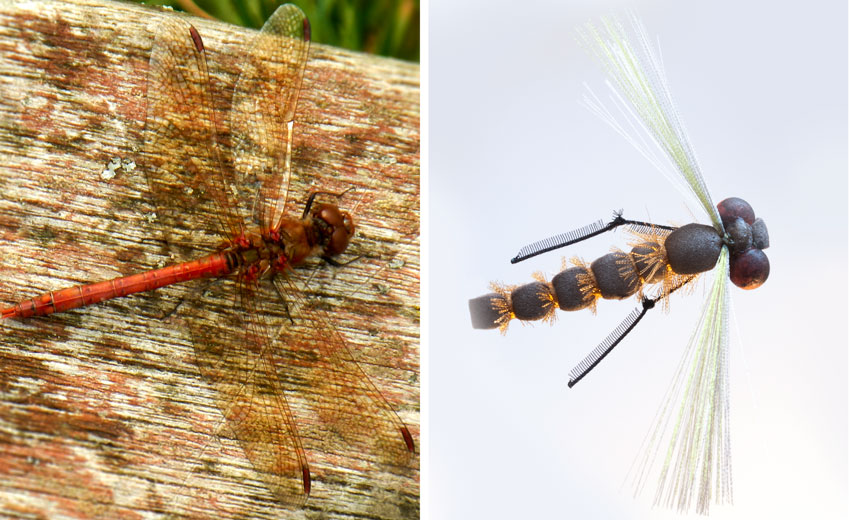
It’s a big fly, but then so are the real ones. The one in the photo above has a 3-inch wing span and looks a bit like a kid’s model aeroplane when it’s hanging from the leader. It’s not designed for casting. It’s a stalking bug, but not in the conventional sense of a small heavily weighted fly for stalking stillwater trout in clear lakes. Many of the lakes I fish for carp don’t lend themselves to casting a fly any distance, with the surrounding trees and bushes precluding any decent back cast. It made sense to me to design a fly specifically for stalking carp and other species cruising the margins without casting. Sneaking among the bushes, crouching under cover and stealthily lowering the fly onto the water is the order of the day with this one.
Making the extended foam body is straightforward using a large darning needle held in your vice. The trick is to use a slippery thread and not to make the initial wraps used to attach the thread too tight. This will allow you to slide the body off the needle when the body is ready to be transferred to the hook.
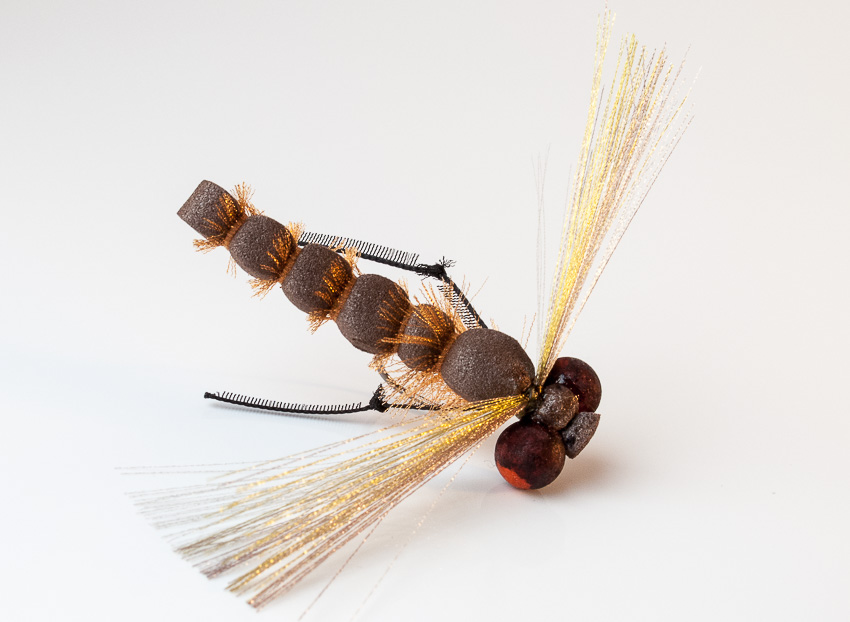
Hook Carp (e.g. Fulling Mill 32500) or heavy wire Czech nymph size 6-8
Thread UTC 70 brown
Body Craft foam 2mm brown
Rib Brown or tan organza ribbon
Legs Black organza ribbon
Wings DNA frosty fish fibres, white, olive and grey
Eyes Veniards Floozeyes
-
Fix a needle in your vice and run on the thread near the tip. Leave a long tag end which will be tied onto the hook later to prevent the body unravelling.
-
Cut a 15cm length of organza ribbon and trim to 5mm wide. Strip out all the long fibres and cut off the short fibres from 1cm at one end to form a tag. Catch in the tag on the needle and secure with a few turns of thread.
-
Cut a 10cm strip of craft foam slightly narrower than the width of the hook gape. Fold the strip in half and taper by cutting either side from the fold to halfway along.
-
Fold the foam around the needle with the organza and tying thread inside. Make a couple of turns of thread around the foam and pull tight to form the first segment. Make two wraps of organza over the thread.
-
Hold back one side of the foam and take the thread and organza inside next to the needle. Move the thread up the needle in open turns over the organza to the position of the next segment.
-
Repeat the segmenting process up the needle a further two or three times. Whip finish in the last segment and cut the thread, again leaving a long tag end. Put a drop of varnish or superglue on the whip finish. Grasp the body firmly and pull off the needle.
-
Vice the hook, run on the thread at the eye and take back to the bend in touching turns. Run the thread up and down the shank a few times in open turns to form a base for attaching the foam body, and return the thread to the bend.
-
Prepare a second 15cm length of organza by trimming and stripping. Tie in at the bend.
-
Apply a smear of superglue to the thread on the shank. Place the body on the hook and secure with tight thread wraps forming a final segment. Fold back the upper piece of foam and bind down the lower piece together with the tag ends of thread and organza along the shank to the eye. Trim away any excess material.
-
Wind the organza around the last segment and then along the hook shank in touching turns to 5mm from the eye. Tie in and cut off the excess.
-
Cut the edge from a length of black organza, tie overhand knots near each end and weld each end in a flame. Cut in half and tie in on either side of the shank.
-
Tie in the Floozeyes behind the hook eye with figure of eight wraps.
-
Taper the upper piece of foam towards the end, bring forward and secure in front of the eyes. Cut off the waste.
-
Take the thread under the shank and make a couple of tight turns to compress the foam behind the eyes.
-
Cut 10cm lengths of frosty fish fibres and mix the colours. Tie in behind the eyes with figure of eight thread wraps. Whip finish and apply a drop of varnish or superglue.
-
Grasp the ends of both wings, pull tight and trim to equal length. Colour the eyes with a black marker pen leaving an uncoloured highlight in the centre.
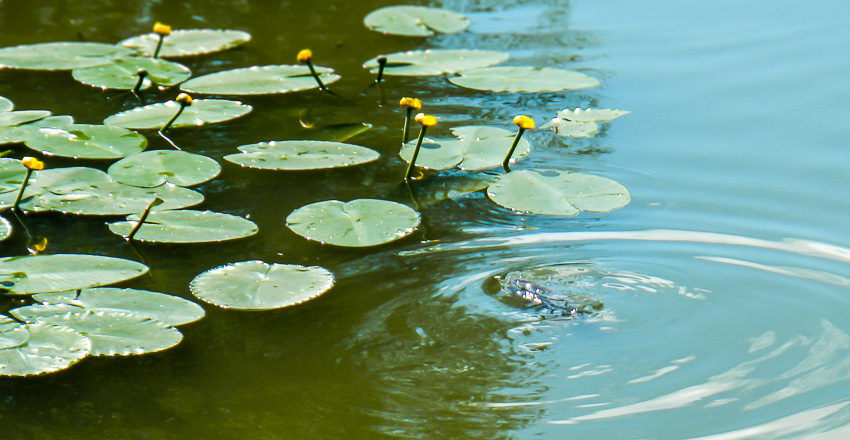
My favourite way of fishing the Stalking Dragon is to lower it onto a patch of lily pads, wait for a fish to mooch along and then twitch the fly off the leaves onto the water. This often induces a solid swirling take followed by a sharply bent rod and a screaming reel as the fish attempts to regain the safety of the lilies. Strong tippet is the order of the day; no need for subtlety here, the fish will never see the leader, so 10lb or heavier is appropriate. Make sure you tie the fly on a good strong hook; holding a big carp at short range puts a lot of strain on a hook and standard trout fly hooks are not usually up to the job.
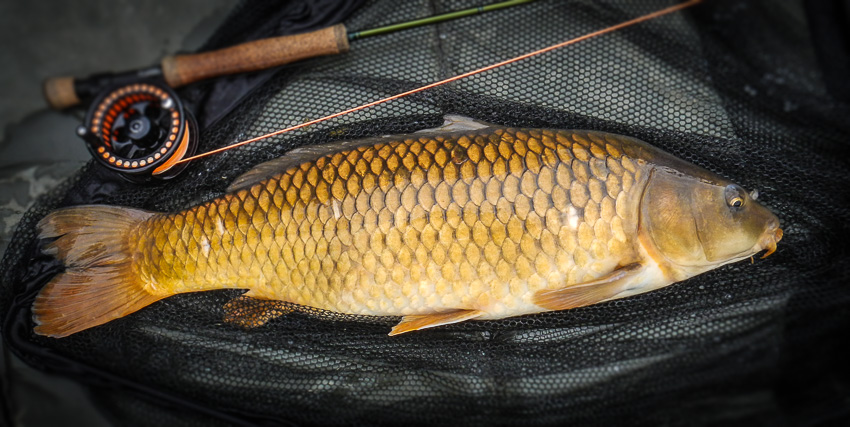
While this is primarily a carp fly, I’ve also caught several other species including bream, roach and perch on it. The prospect of a large juicy meal seems to induce fish that you would not normally expect to take such an offering to manage to get their small mouths around a huge fly. Some of the roach were only a little bigger than the fly itself.
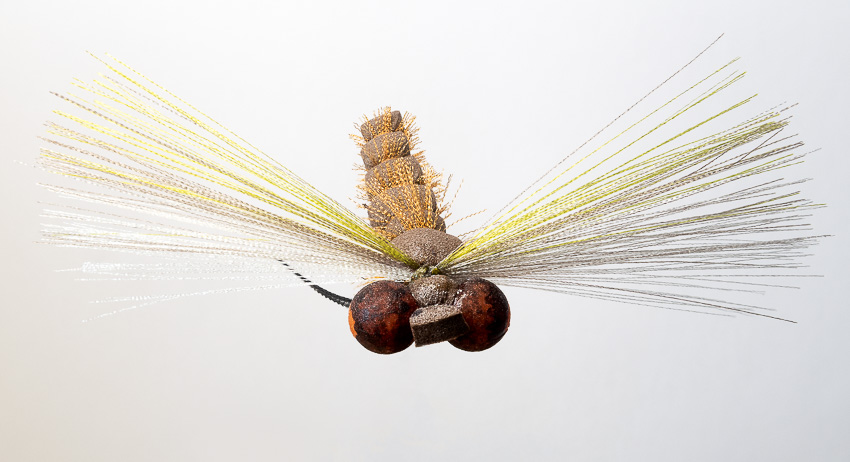
Nick Thomas lives in South Wales. He started fly fishing on Scottish hill lochs many years ago and continues to design, tie and fish flies for trout, grayling, carp, bass and anything else that’s going.